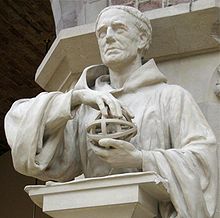User:Jiawei Zou/sandbox
Gunpowder in Europe[edit]
The Europeans in the Eurasian region were among the major groups. However, they were the last to learn about the secret of gunpowder but that did not prevent them from making a name in the development of gunpowder just as the gunpowder empires. Europeans are said to have pushed gunpowder technology to its limits and improved the formulas that existed and devised new uses of the substance[1].


The introduction of gunpowder in Europe came through the rich Silk Road Trade in the thirteenth century[2]. During the time, the chemical formula for gunpowder and process of refinement that reached Europe was already in completed form. Roger Bacon, a renowned early European alchemist (1214 – 1292), set forth the marvels of the world and key among them was listing the ingredients of gunpowder which was very instrumental in guiding Europeans in advancing the technology of gunpowder. Having the ingredients revealed to them, European scientists, inventors and alchemists were ready to improve gunpowder and they created corned gunpowder. The corned gunpowder was the same as the normal gunpowder in terms of chemical composition but had a different refinement process. This process entailed mixing adding a wet substance to the gunpowder and then drying it up as a mixture. With this improved gunpowder technology, German friar, Berthold Schwarz invented the first European cannon in 1353[3]. The Europeans improved the gunpowder firearms which had been made in China and Middle East and out of this improvement the Europeans metalsmiths were able to create stronger and more durable rifles using their advanced European metal work techniques[4]. The Europeans also learnt how to calculate the amount of force of the gas that is contained in the gun chamber. The result of this knowledge was that the Europeans made guns that had the power to fire greater distances[4].
Though Europe was not mentioned among the gunpowder empires, its contribution to the gunpowder technology advancement in the Eurasian region and the world is so significant that it cannot be ignored. Though gunpowder did not even originate from Europe, major advancement was made there. In fact, Europeans were still improving gunpowder a century after the first gun was invented in China and by Chinese[5]. Improved gunpowder from Europe would later in 1520 AD reach China by a Portuguese ship[6]. The Portuguese introduced the cannon, improved rifles and other European advancements to the Chinese. The Europeans had returned the gunpowder substance to its origin hundreds of years after the invention in China and this brought gunpowder's journey through Asia a full circle.
- ^ Cullen, Christopher (2011). Günergun, Feza; Raina, Dhruv (eds.). "Reflections on the Transmission and Transformation of Technologies: Agriculture, Printing and Gunpowder between East and West". Science between Europe and Asia. Boston Studies in the Philosophy of Science. Springer Netherlands: 13–26. doi:10.1007/978-90-481-9968-6_2. ISBN 9789048199686.
- ^ Wang, Yiwei (2015). "China's "New Silk Road": A Case Study in EU-China Relations" (PDF). ISPI Report Xi’s Policy Gambles: The Bumpy Road Ahead, ISPI, Beijing, China. 3: 92–109.
{{cite journal}}: line feed character in|title=at position 18 (help) - ^ Ffoulkes, Charles John (1969). The Gun-founders of England. CUP Archive.
- ^ a b Rogers, Clifford (2018). The military revolution debate: readings on the military transformation of early modern Europe. Europe: Routledge.
- ^ Ling, Wang (1947-07-01). "On the Invention and Use of Gunpowder and Firearms in China". Isis. 37 (3/4): 160–178. doi:10.1086/348023. ISSN 0021-1753.
- ^ Tian, Robert Guang (2016-02-08). Journal of China Marketing Volume 6 (1): Volume 6 (1). Cambridge Scholars Publishing. ISBN 9781443888332.

